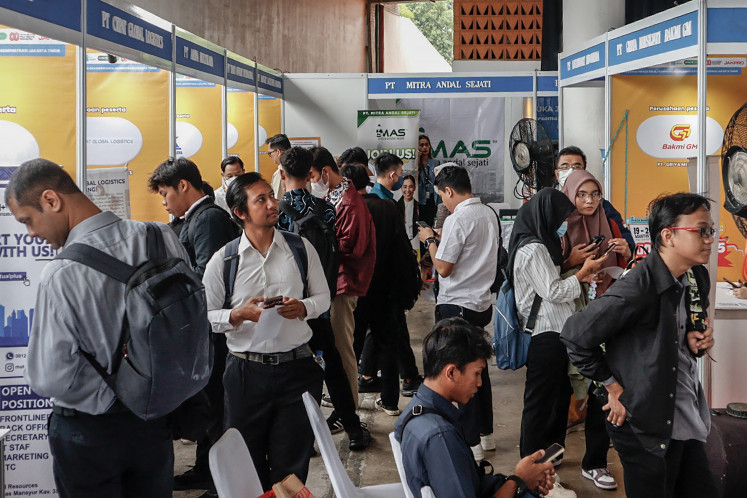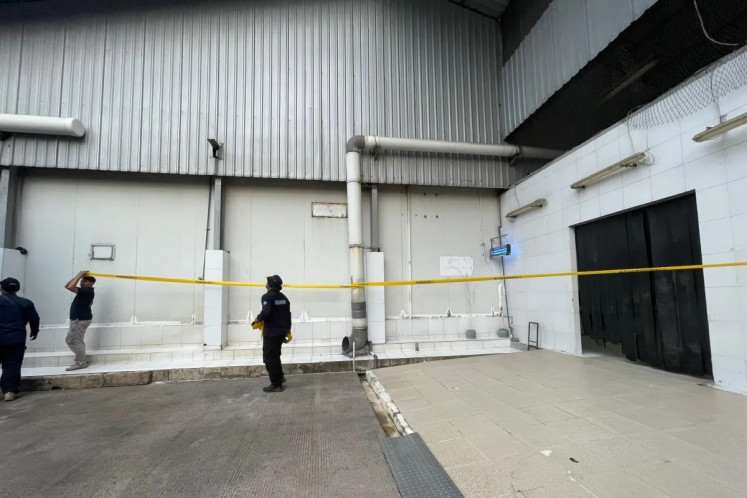Popular Reads
Top Results
Can't find what you're looking for?
View all search resultsPopular Reads
Top Results
Can't find what you're looking for?
View all search resultsWomen show off 'jamu' skill in festival
Up close: A jamu seller sports a beautiful kebaya and batik wrap as she hauls her traditional medicine as part of the competition
Change text size
Gift Premium Articles
to Anyone
Up close: A jamu seller sports a beautiful kebaya and batik wrap as she hauls her traditional medicine as part of the competition.
The air was full of the scent of spices, keroncong music played in the background and electric blenders ground turmeric and pestles pounded mortars at the recent Jamu Gendong Festival in Batu, East Java.
Makers of the traditional herbal medicine gathered from throughout the province for the festival, showing off family recipes ' and how they carried baskets full of jamu.
Jamu gendong is the term given to those who sell jamu in the street.
Vendors traditionally carry bottles of different herbal medicine in a woven basket tied with a cloth around their body.
The sellers, mostly women, are called mbok jamu [sister jamu], regardless of age.
The festival's 36 participants included the elderly, housewives and teenagers who came to preserve and show off their expertise in traditional Javanese medicinal knowledge.
The women, mostly mbok jamu, were required to concoct two different remedies as part of the competition: jamu kunir asem and jamu cabe puyang.
Jamu kunir asem reputedly enhances breast-milk production while reducing body odor. Jamu cabe puyang, meanwhile, is said to be good for curing colds and stiff muscles.
To make kunir asem, the participants were given lempuyang, a type of ginger; sand ginger; galangals and betel leaves; while the main ingredients of cabe puyang included a stem of a bird's eye chili pepper; the herbaceous plants temu ireng and temulawak, ginger; turmeric; pepper; tamarind and palm sugar.
Secret recipe: Ingredients include, among other things, the stem of a bird's eye chili pepper; the herbaceous plants temu ireng and temulawak, ginger; turmeric; pepper; tamarind and palm sugar.
Herbal remedy: The measurement of ingredients is made by how many stems, leaves or stalks are used.
The spices were soaked in water for four hours before they were pounded and mixed with boiled water. After cooling, the dregs were separated using strainers and the water kept in bottles.
Measurement of ingredients was by how many stems, leaves or stalks were used.
'I've been doing this for 35 years and carry the jamu on my body, but recently I started using a pushcart instead,' said 64-year-old mbok jamu Tiasri.
'At home, I use the mortar to pound the spices with my own hand. I only use the blender for this competition.'
On the go: Traditional herbal medicine vendors, are judged on their sales calls, presentation as well as the quality of their jamu.
The judges observed, sampled and interviewed the participants on their jamu making process, including hygiene.
The variants of the spices used and the final taste were the main criteria for the competition.
In the last part of the competition, the judges gave the contestants a score for their appearance, movement, sales calls and presentation of the drink.
An mbok jamu's standard costume includes a kebaya, batik cloth and selendang (wrap) to tie the woven basket in. They typically carry 12 kilograms as a full load.
Even though jamu has grown in popularity along with a growing back-to-nature trend, traditional jamu makers complain of scarce ingredients in developing their business.
Agnes, 17, a student at a local vocational high school, said that she took part in the festival to practice the knowledge she learned from school.
'I'm glad to be in the competition with the mbok jamu, because I can learn more from their experiences in making jamu.'
' Photos by Aman Rochman














